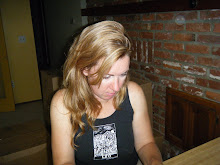Wednesday, October 31, 2012
Physical - Mental- Emotional
In the beginning of my horsemanship I mistook conditioning a horse physically for training a horses mind. After all if you could get his feet to do what you wanted wouldn't that mean his mind was somehow involved? The repetition of the patterns I was instructed to ride and the exercises I practiced where for the purpose of performance. If the horse could do his "job" in the ring surely he must be well trained. Its a notion that started to take a jostling as soon as I got my first job at a fancy hunter barn. One of the most decorated horses in their string of impressive show horses had to have his bridle taken apart and reconstructed on his head every ride. The reverse had to happen when removing it. He was not happy about grooming especially his face and upper neck. Leading him could be challenging in new environments and on occasion he had to be backed into a schooling ring as he would refuse to go forward with his rider. Once in the arena though, he was all business usually winning a blue ribbon for his flawless form over fences. He was well loved and considered quirky not untrained. Looking back I can see how that horse had the barest level of training that dealt only in his physical preparedness and that his mental and emotional preparedness were nonexistent. A horse becomes mentally prepared for his job when it is presented to him in a way he understands. For some horses that means tiny steps repeated often, for others it means a little of this, a little of that and heres how these things connect. Still others will read the book and get back to you in the morning with an idea of what happens in the next book in the series.(Haven't we all had one of those types in our barns at one time or another?) As a trainer( thats who ever is imparting the knowledge to the horse) its important to know what type you are working with. The third element to a well trained horse is emotional preparedness. This is a trickier topic, as there are many approaches to accomplishing this. There is flooding,approach - retreat,positive reinforcement, negative reinforcement,and ignoring the topic all together as froo froo fairy dust talk. Recently I attended a Buck Brannamen clinic where emotional training was brought home to me on a very personal level. Ironically the gal who's experience I will share with you next is named Beth as well. The morning session was colt starting so 20 riders give or take a few, got on their baby horses for the first time in front of an audience and with 20 of their closest friends. If that wasnt anxiety producing enough they then as a group had to walk trot and canter for the first time with the help of Buck and his amazing bridle horse Rebel. The horse Beth was riding was a very busy, very excitable grey warmblood. Buck started right of with her making sure she could turn on the haunch left and then right in order to slow and control her horse should it get out of control. She had to use first one rein then the other as Buck flagged them along the rail. The grim look of determination on Beths face told the story of how little fun this exercise was and we all breathed a sigh of relief when he let her exit the round pen as he moved on to others in her group. Like her I had had that same feeling of "thank god its over and I lived" at John's Where we had the same treatment except all alone in our own round pen with John at the helm until he felt we could execute the emergency stop effectively. This experience was so traumatic for me that I vowed never to subject my students to it. Sorry guys, I messed up, I should have terrorized you on horse back....really! Read on... Beth's sigh of relief was relatively short lived as Buck called her back into the round pen. You could almost see her sag a little, or maybe that was me, feeling for her. Back in she came and the process began again. This time though in short order, the horse began to lose its frantic, jerky responses and develop a sense of balance and grace to its movements. You could see the light come on in the horses head. When Beth realized how her horse was changing you could see her begin to relax. Her responses where less mechanical and more natural. Again she was allowed to leave the round pen. This time she was beaming. On her third trip in, she and the horse where practically dancing. Not only had the mechanics been mastered but both had received the emotional training they needed to have confidence in one another. You see,its more than being physically prepared to do a job, and mentally aware of what is involved, its about understanding that you can really do it and that your horse is right there in it with you, connected. What I experienced stopped at mental. We physically performed, I mentally knew what to do but emotionally I never wanted to do it again. How does this relate to the blue ribbon hunter at the beginning of this tome? Well, he was physically able to do his job and do it well, and in certain environments you might say he was mentally able to keep up, but emotionally he was unprepared as evident by his reactive behaviour outside of the arena. This is the trilogy of horse training. Its not complete without all parts being in place. How will you know when they are all there? It will be a dance and everyone will be smiling.
Subscribe to:
Post Comments (Atom)



No comments:
Post a Comment